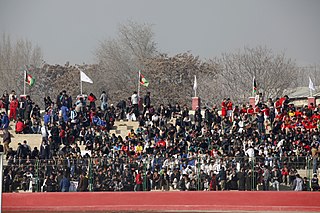Hazrat-e Sa`id Ḩaẕrat-e Sa`īd | |
|---|---|
| Coordinates: 36°27′53″N70°46′27″E / 36.46472°N 70.77417°E Coordinates: 36°27′53″N70°46′27″E / 36.46472°N 70.77417°E | |
| Country | |
| Province | Badakhshan Province |
| District | Yamgan |
| Time zone | + 4.30 |
Hazrat-e Sa`id is a village in Badakhshan Province in north-eastern Afghanistan. [1] It is located on the Kokcha River and is on the road to Jurm, about ten miles north of Garghamu. [2]

A village is a clustered human settlement or community, larger than a hamlet but smaller than a town, with a population ranging from a few hundred to a few thousand. Though villages are often located in rural areas, the term urban village is also applied to certain urban neighborhoods. Villages are normally permanent, with fixed dwellings; however, transient villages can occur. Further, the dwellings of a village are fairly close to one another, not scattered broadly over the landscape, as a dispersed settlement.

Badakhshan Province is one of the 34 provinces of Afghanistan, located in the farthest northeastern part of the country between Tajikistan and northern Pakistan. It shares a 56.5-mile (91 km) border with China.

Afghanistan, officially the Islamic Republic of Afghanistan, is a landlocked country located in South-Central Asia. Afghanistan is bordered by Pakistan in the south and east; Iran in the west; Turkmenistan, Uzbekistan, and Tajikistan in the north; and in the far northeast, China. Its territory covers 652,000 square kilometers (252,000 sq mi) and much of it is covered by the Hindu Kush mountain range, which experiences very cold winters. The north consists of fertile plains, while the south-west consists of deserts where temperatures can get very hot in summers. Kabul serves as the capital and its largest city.



